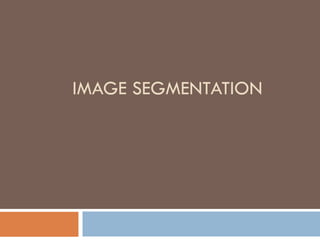
IMAGE SEGMENTATION TECHNIQUES
- 2. Introduction Image segmentation divides an image into regions that are connected and have some similarity within the region and some difference between adjacent regions. The goal is usually to find individual objects in an image. For the most part there are fundamentally two kinds of approaches to segmentation: discontinuity and similarity. Similarity may be due to pixel intensity, color or texture. Differences are sudden changes (discontinuities) in any of these, but especially sudden changes in intensity along a boundary line, which is called an edge.
- 3. Detection of Discontinuities There are three kinds of discontinuities of intensity: points, lines and edges. The most common way to look for discontinuities is to scan a small mask over the image. The mask determines which kind of discontinuity to look for. 9 1 9 9 2 2 1 1 ... i i i z w z w z w z w R General 3x3 Mask
- 5. Line Detection Only slightly more common than point detection is to find a one pixel wide line in an image. For digital images the only three point straight lines are only horizontal, vertical, or diagonal (+ or –45). Line Masks
- 9. Gradient operators Roberts cross-gradient operators Prewitt operators Sobel operators
- 10. Edge Linking and Boundary Detection Local Processing Two properties of edge points are useful for edge linking: the strength (or magnitude) of the detected edge points their directions (determined from gradient directions) This is usually done in local neighborhoods. Adjacent edge points with similar magnitude and direction are linked. For example, an edge pixel with coordinates (x0,y0) in a predefined neighborhood of (x,y) is similar to the pixel at (x,y) if threshold e nonnegativ a : , ) , ( ) , ( 0 0 E E y x y x f threshold angle nonegative a : , ) , ( ) , ( 0 0 A A y x y x
- 11. Example In this example, we can find the license plate candidate after edge linking process.
- 12. Thresholding • Intensity histogram in Fig. 10.35(a) corresponds to an image f(x,y) composed of light object on dark background. • To extract object from the background, we have to set a threshold T, such that any point (x, y) in image at which f(x, y) > T is called object point; otherwise, background point. • The segmented image g(x, y) is given by: (10.3-1)
- 13. Thresholding • Intensity histogram in Fig. 10.35(b) corresponds to an image f(x,y) composed of two types of light objects on a dark background. • The segmented image g(x, y) is given by: (10.3-2) where, a, b and c are three distinct intensity values.
- 14. Basic Global Thresholding The following iterative algorithm is used for obtaining basic global threshold. Parameter ∆T controls the number of iterations. Larger ∆T is, fewer iterations the algorithm will perform.
- 15. Optimum Global Thresholding OTSU • The Otsu’s method is optimum in the sense that it maximizes the between-class variance. • In addition, Otsu method is based entirely on computations performed on image histogram, an easily obtainable 1D array. • Otsu’s algorithm may be summarized as follows:
- 18. Region based segmentation Edges and thresholds sometimes do not give good results for segmentation. Region-based segmentation is based on the connectivity of similar pixels in a region. Each region must be uniform. Connectivity of the pixels within the region is very important. There are two main approaches to region-based segmentation: region growing and region splitting.
- 19. Basic Formulation Let R represent the entire image region. Segmentation is a process that partitions R into subregions, R1,R2,…,Rn, such that where P(Rk): a logical predicate defined over the points in set Rk For example: P(Rk)=TRUE if all pixels in Rk have the same gray level. R Ri n i 1 (a) n i Ri ,..., 2 , 1 region, connected a is (b) j i j i R R j i , and all for (c) n i R P i ,..., 2 , 1 for TRUE ) ( (d) j i j i R R R R P and regions adjacent any for FALSE ) ( (e)
- 20. Region Growing
- 21. Region splitting and merging Region splitting is the opposite of region growing. First there is a large region (possible the entire image). Then a predicate (measurement) is used to determine if the region is uniform. If not, then the method requires that the region be split into two regions. Then each of these two regions is independently tested by the predicate (measurement). This procedure continues until all resulting regions are uniform.
- 22. Region splitting and merging The main problem with region splitting is determining where to split a region. One method to divide a region is to use a quadtree structure. Quadtree: a tree in which nodes have exactly four descendants.
- 23. Region splitting and merging The split and merge procedure: Split into four disjoint quadrants any region Ri for which P(Ri) = FALSE. Merge any adjacent regions Rj and Rk for which P(Rj U Rk) = TRUE. (the quadtree structure may not be preserved) Stop when no further merging or splitting is possible.
